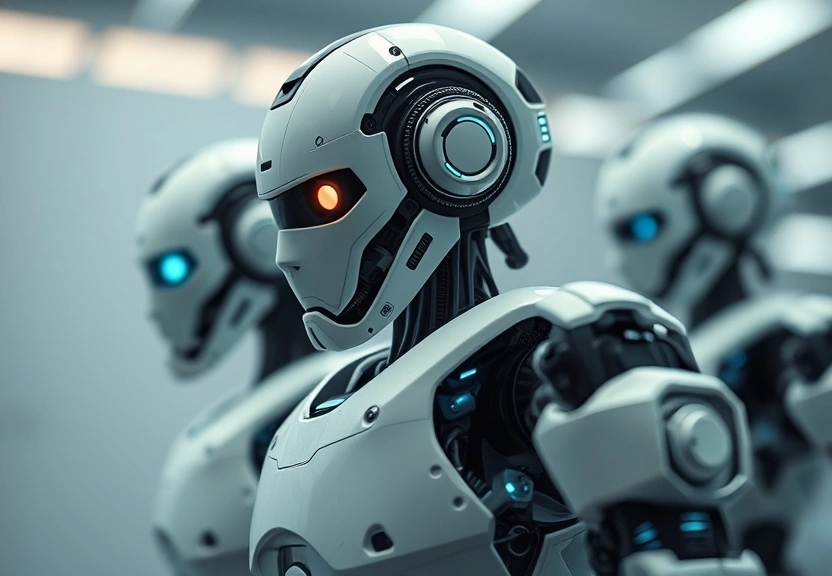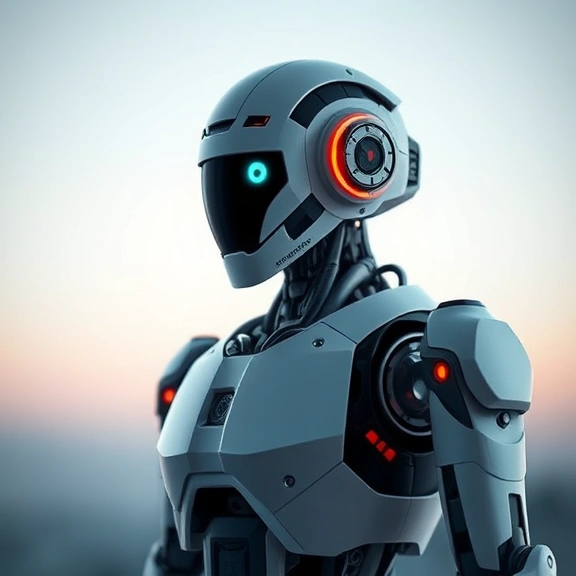The Rise of General Purpose Humanoid Robots: Exploring the Breakthroughs of 2025
Imagine a world where your daily life is seamlessly intertwined with technology, where robots not only vacuum your home but engage in meaningful conversations, assist in healthcare, and perhaps even become your companions. It’s a world many of us envisioned as a distant future, one painted in the vivid colors of science fiction. Yet, this world is not so far removed from our reality. The year 2025 marks a turning point in the realm of general purpose humanoid robots, a milestone where technology and humanity blend to create extraordinary possibilities.

Reflecting on this monumental shift, you might recall the first time you interacted with technology that seemed almost human-like. That moment when you asked a digital assistant a question and received an eerily accurate response. Or perhaps when you saw a robot on television performing tasks once reserved for humans and thought to yourself, “How far can this go?” Your curiosity is not unique. It’s a shared anticipation that fuels the progress in humanoid robot technology, aiming to revolutionize the way we live, work, and interact.
What excites you most about the integration of robots into our daily lives? Is it the promise of easing human labor, the potential for personalized education, or perhaps the idea of companionship for the elderly? These are the questions we all ponder, and they guide the many breakthroughs in robotics. As you delve into the following sections, you’ll gain insight into how these innovations are shaping the present and predicting the future.
As you navigate this exploration, keep in mind that the very essence of these advancements lies in their practicality, how they will serve you and society at large. Let’s embark on this journey into 2025, where the rise of general purpose humanoid robots is not just a technological evolution but a profound revolution in how we perceive our capabilities and limitations.
The Evolution of Humanoid Robot Technology
Early Innovations and Their Impact
In the early days, humanoid robots were confined to the pages of science fiction. However, rapid advancements in AI and machine learning have made these robots a reality. Early prototypes focused primarily on mobility and basic interaction.
- Robots like ASIMO laid the groundwork by demonstrating walking, running, and stair-climbing capabilities.
- Initial AI advancements allowed robots to recognize voices and basic facial expressions, setting the stage for more complex interactions.
These early innovations served as a catalyst for further development, proving that humanoid robots could indeed perform tasks that mirrored human abilities.
AI Advancements in Robotics
The integration of artificial intelligence has been pivotal in advancing humanoid robots. AI allows these machines to process information and learn from their environment.
- Natural language processing enables robots to engage in more sophisticated conversations.
- Machine learning algorithms allow robots to improve their performance over time without human intervention.
This continuous learning capability is essential for general purpose humanoid robots, as it enables them to adapt to various roles and environments.
Robotics Breakthroughs 2025
The breakthroughs of 2025 are nothing short of revolutionary. Enhanced sensors and AI-driven software have transformed humanoid robots into capable entities equipped for diverse applications.
- Improved tactile sensors give robots a sense of touch, allowing for delicate operations.
- Advanced vision systems enable robots to navigate complex environments with ease.
These breakthroughs represent a significant leap forward, making the integration of humanoid robots into everyday life more feasible than ever before.
Applications of General Purpose Humanoid Robots
Healthcare and Elderly Care
In healthcare, humanoid robots are breaking new ground by providing support that extends beyond basic assistance.
- Robots monitor patients’ vital signs, offering real-time data to healthcare professionals.
- They assist with physical therapy, providing personalized rehabilitation exercises.
For the elderly, these robots offer companionship and independence, reducing the need for continuous human oversight.
Educational Support
Imagine a classroom where humanoid robots serve as teaching assistants, bringing a new dimension to learning.
- Robots personalize lessons to accommodate different learning styles and paces.
- They engage students through interactive activities, fostering a more dynamic educational environment.
By supplementing traditional teaching methods, these robots enhance the educational experience for both students and teachers.
Industrial and Domestic Assistance
In industrial settings, humanoid robots are taking on roles that were once deemed too dangerous or monotonous for humans.
- Robots perform repetitive tasks with precision, improving efficiency and reducing human error.
- In homes, they manage chores, allowing you to focus on more meaningful activities.
These applications underscore the versatility of general purpose humanoid robots in both public and private sectors.
🎥 Vídeo complementar sobre o tópico
Challenges and Ethical Considerations
Technical Limitations
Despite the impressive advancements, humanoid robots still face technical challenges that hinder their full potential.
- Battery life remains a significant hurdle, limiting the duration of autonomous operation.
- Complex environments require advanced navigation algorithms, which are still under development.
Addressing these limitations is crucial for the widespread adoption of humanoid robots.
Ethical Implications
The integration of robots into society raises ethical questions that cannot be overlooked.
- Privacy concerns arise due to the data collected by robots during their interactions.
- There’s an ongoing debate about the potential loss of jobs as robots assume roles traditionally held by humans.
These ethical considerations highlight the need for policies that ensure responsible development and deployment of humanoid robots.
Social Acceptance
The successful integration of humanoid robots will largely depend on societal acceptance.
- Public perception is influenced by cultural attitudes and media portrayals of robots.
- Building trust through transparency and education is key to overcoming resistance.
Fostering a positive relationship between humans and robots is essential for a harmonious coexistence.
The Future of Humanoid Robots
Predictions for 2030 and Beyond
Looking ahead, the future of humanoid robots promises even greater advancements and broader applications.
- Robots are expected to become more autonomous, reducing the need for human intervention.
- Collaboration between humans and robots will create new opportunities in various industries.
These predictions underscore the transformative potential of humanoid robots in the years to come.
Innovative Uses in Emerging Fields
As technology evolves, new fields will emerge where humanoid robots can make a significant impact.
- In space exploration, robots can undertake missions that are too hazardous for humans.
- Robots may become integral to disaster response, providing rapid assistance in emergencies.
These innovative applications highlight the versatility and adaptability of humanoid robots in addressing global challenges.
Robot Integration in Society
For robots to integrate seamlessly into society, a collaborative effort is required from all stakeholders.
- Policy frameworks must be established to govern the ethical use of robots.
- Public education initiatives can help demystify robot technology and foster acceptance.
By working together, we can ensure that humanoid robots enhance, rather than disrupt, societal norms.
Case Studies: Successful Robot Implementations
Healthcare Revolution with Robots
Case studies in healthcare show how humanoid robots are transforming patient care.
- In Japan, robots are used in hospitals to assist with patient monitoring and support.
- These robots have reduced the workload on healthcare professionals, allowing them to focus on more complex tasks.
The success of these implementations demonstrates the tangible benefits of integrating robots into healthcare.
Educational Transformation
Schools worldwide are adopting robots as educational tools, reshaping the learning experience.
- In South Korea, robots are used to teach English to students, enhancing language acquisition.
- These robots provide interactive lessons, engaging students in a way that traditional methods cannot.
The positive outcomes of these programs illustrate the potential of robots to enrich education.
Industrial Efficiency
Industrial applications of humanoid robots showcase their ability to increase efficiency and safety.
- In automotive manufacturing, robots perform tasks with precision and consistency.
- This has resulted in higher production rates and improved product quality.
The widespread adoption of robots in industry highlights their role in enhancing productivity and competitiveness.

Frequently Asked Questions about Humanoid Robots 2025
What are humanoid robots?
Humanoid robots are robots designed to resemble and mimic human behavior. They often have a head, torso, arms, and legs, and they can perform tasks that require human-like dexterity and cognitive abilities. These robots are equipped with sensors and AI to interact with their environment and the people in it.
How are humanoid robots being used in 2025?
By 2025, humanoid robots are utilized in various sectors, including healthcare, education, industry, and domestic settings. They assist in patient care, provide personalized education, perform industrial tasks, and manage household chores. Their versatility makes them suitable for a wide range of applications.
What are the main challenges facing humanoid robots?
The main challenges include technical limitations such as battery life and navigation in complex environments. Ethical considerations, privacy concerns, and social acceptance also pose significant hurdles. Overcoming these challenges is vital for the successful integration of humanoid robots into society.
What advancements have been made in humanoid robot technology?
Recent advancements include improved AI capabilities, enhanced sensors, and better machine learning algorithms. Robots now possess advanced vision systems, tactile sensors, and natural language processing, enabling them to perform complex tasks and interact more effectively with humans.
How do humanoid robots impact employment?
Humanoid robots have the potential to displace certain jobs, particularly those involving repetitive or dangerous tasks. However, they also create new opportunities by taking over mundane tasks, allowing humans to focus on more creative and strategic roles. It’s crucial to develop policies that address these impacts.
Can humanoid robots learn and adapt over time?
Yes, humanoid robots use machine learning algorithms to learn from their experiences and improve over time. This ability to adapt is essential for general purpose robots, as it enables them to perform a variety of tasks and adjust to new environments without human intervention.
What ethical considerations are associated with humanoid robots?
Ethical considerations include privacy concerns due to data collection, the potential loss of jobs, and the implications of human-robot interactions. As robots become more integrated into daily life, it is essential to establish ethical guidelines that ensure their responsible development and use.
How can humanoid robots enhance education?
In education, humanoid robots serve as teaching assistants that offer personalized learning experiences. They adapt to different student needs, provide interactive lessons, and engage students in a way that traditional methods cannot. This can enhance educational outcomes and foster a more engaging learning environment.
Conclusion: Embracing the Future with Humanoid Robots
The rise of general purpose humanoid robots marks a pivotal moment in our technological evolution. As you navigate this transformative landscape, it’s important to embrace both the opportunities and challenges it presents. These robots are not merely tools; they are partners in reshaping how we live and work. By understanding their potential and addressing the associated challenges, you can play a role in crafting a future where technology enhances human capabilities.
As you consider the integration of humanoid robots into various aspects of life, reflect on their potential to improve healthcare, revolutionize education, and boost industrial efficiency. These advancements are more than mere technological triumphs; they represent a collective stride towards a more efficient, connected, and compassionate world.
Your engagement in this dialogue is crucial. Whether advocating for responsible development, participating in discussions about ethical implications, or simply staying informed, your actions contribute to shaping a future where humanoid robots are seamlessly integrated into society. Let this be a call to action to explore, learn, and adapt alongside these technological marvels.
In embracing the future with humanoid robots, you are not just witnessing a moment in history; you are part of a movement that harmonizes human ingenuity with technological innovation. Together, let’s look forward to a future where the lines between the technological and the human are not barriers but bridges of endless possibilities.






